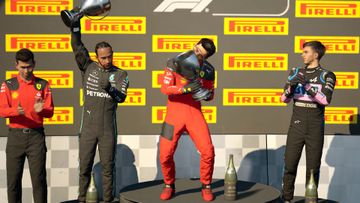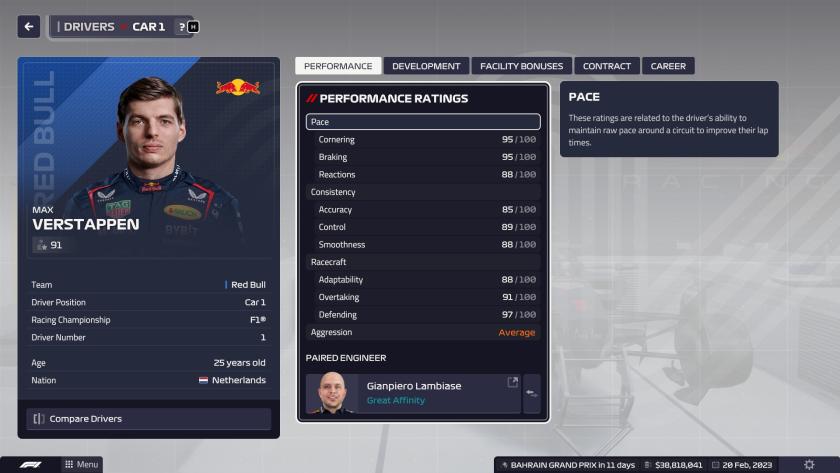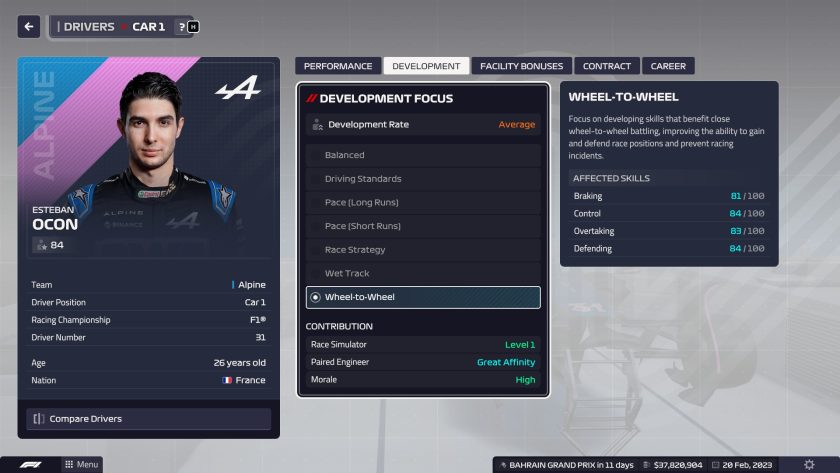
F1® Manager 23 Drivers Guide
An introduction to finding, developing and managing drivers in F1® Manager 23.
You can spend years developing an F1® car capable of winning the Constructors’ Championship, but you won't get near the podium without a world-class driver to drive it. In F1® Manager 23, drivers are the heart of your team, and you need to spend time fostering their skills, building their confidence ahead of race day, and keeping their morale high if you want a chance to win the season.
As Team Principal your impact on your drivers will make the difference between success and failure on the tarmac. This F1® Manager 23 Drivers guide will give you an overview of how drivers work and what you need to pay attention to in your first season.
Not all drivers are created equal

Every driver in F1® has different strengths and weaknesses. Max Verstappen has the edge over Lewis Hamilton when it comes to defending overtakes. Still, Hamilton has better control of his vehicle, reducing his chance of on-track incidents, like locking his brakes or spinning on a turn.
In F1® Manager 23, you can see a breakdown of your driver's abilities on the Drivers window. You can see individual scores for their skills, such as cornering, overtaking, and braking. All those attributes combine to make an overall score for each driver. Though you can see the detailed breakdown of your drivers, you can only see the overall score of other teams’ drivers. For more information, you must send your scouts to analyse their performance.
Foster the talent you have

Your drivers will continue to develop their skills across a season, from the experience they gain on the track and in simulator practice between race events. After analysing their abilities in the Drivers window, you can tell your talent which areas they should focus on improving. For instance, a driver that spends time working on Driving Standards will get better at overtaking and defending.
If you invest in facility upgrades like the Race Simulator, drivers' skills will develop more quickly. Though, you will see the fastest development in younger drivers. So, if you believe a driver isn’t currently performing at the level you need, you will need to make the call on whether you can support them until they have improved their skills or if you will need to bring in a new face.
Each driver also has a Development Rate that decreases with age. If your older drivers aren’t achieving results on the track, it’s up to you to decide how much leeway you give to an underperforming veteran, as it may be time to look to the future with younger, fast-improving talent.
Driver Confidence

Drivers aren’t simply numbers on a page in F1® Manager 23; you must ensure they’re comfortable behind the wheel in every race. One of the biggest boosts you can give yourself in a Grand Prix is ensuring your drivers are confident on race day. A driver with low confidence is at a higher risk of making a mistake on the track, so to get the best out of them, you need to make sure they start the race focused on the win.
Drivers can suffer hits to their confidence during the race, too. If they can’t fight off an overtake, lock up on a turn, or are involved in a collision, it will leave them shaken, and they will become more likely to make a mistake. However, having a good relationship with their Race Engineer can reduce that loss of confidence.
You can read more about that relationship in our F1® Manager 23 Staff guide.
The critical part of a race weekend when a driver builds up their confidence is during Practice. Ahead of most races, drivers have three sessions to drive around the track, getting acclimatised to the circuit and the car and making tweaks to the vehicle's balance so it’s well adapted to the needs of the Grand Prix.
Track Acclimatisation and Car Parts Knowledge

Track Acclimatisation is a stat that represents your driver’s familiarity with the layout of a circuit. The more time a driver spends looping the track in Practice, the higher this stat will become. Over the course of three sessions, so long as they don’t spend too long in the pits making adjustments to their car, drivers will enter Qualifying with a strong knowledge of the circuit.
Car Parts Knowledge represents a driver’s familiarity with each part fitted to their vehicle. Whereas Track Acclimatisation resets to zero between race events, with the driver having to learn each track anew, a driver’s Car Parts Knowledge carries between races. However, when you fit new parts into a car, their familiarity with the vehicle will reduce, and they must build that stat again.
Setup Satisfaction

Track Acclimatisation and Car Parts Knowledge are important, each representing a share of a driver’s pre-race confidence , but by far the most significant factor is Setup Satisfaction. This score shows how well the car is balanced to the circuit they’re racing on. This single stat contributes to half of a driver’s confidence, so you shouldn’t ignore it.
As your drivers participate in practice, they will gather feedback on their car’s performance and communicate it to their Race Engineer. When they’ve had enough time in the car, they will also tell you how satisfied they are with the current setup, marking it as a score out of 100% and grading different elements of the car between bad and optimal. You then can adjust various aspects of the vehicle and address your driver’s feedback. Your driver will then retest the car and tell you if you can improve it further. The closer you get a driver’s Setup Satisfaction to 100%, the more confident they will be in the race.
For a more detailed look at car balance, read our F1® Manager 23 Setups guide.
Driver Morale

Your drivers’ morale also impacts their confidence. This is a stat based on how happy they are in their contract, how well they get on with the rest of the staff, and how proud they are to be part of the team.
A winning team is a happy team, and performing well at race weekends will raise your driver’s morale, but that’s only one of the ways you can keep your drivers buoyed up. The Race Engineer is a driver’s primary point of contact on the track. The longer a driver and race engineer work together, the higher that affinity will become, though sometimes, as Team Principal, you will be asked to intervene if relationships sour.
You can also boost morale by investing in facilities such as the Team Hub and Memorabilia Room.
High morale also plays a key role when it comes to contract negotiation. The higher a driver’s morale, the more patience they will have with your offers. Should your first offer be declined, they will give feedback on why they turned it down and allow you to try again. Drivers with low morale may shut down negotiations, forcing you to find a replacement when their term expires.
Scouting new talent

The current champions of F1® have a lot of young talent hot on their heels, with new winners every week in the F2® and F3® Championships. While you foster your current drivers and develop their skills, a good F1® Principal will also keep track of the drivers in the Feeder Series. If you see a driver doing well in the race reports, you can tell your scouts to give them a closer look. They will provide a detailed breakdown of a driver’s skills and discover how happy they are in their current contracts, giving you the information you need to make a competitive offer.

If you hope to take the top spot in the Constructors’ Championship in F1 Manager 23, you will need your drivers on side and as dedicated to coming first as you are. You should take advantage of every system in your hands to bolster their morale and confidence.
Leading your drivers’ development and directing them on the track during a race weekend is a core part of your work as a Team Principal. If you can keep their confidence and morale high by managing their staff relations and taking the time to make them comfortable in their vehicle each Grand Prix, then your drivers will pay you back with consistent performance on the circuit.
For an introduction to the other core duties of a Team Principal, read our F1® Manager 23 Beginner’s guide.
F1® Manager 2024
Lead your team to glory in F1® Manager 2024. Build a legacy with one of 10 official F1® constructors or create your very own team.









